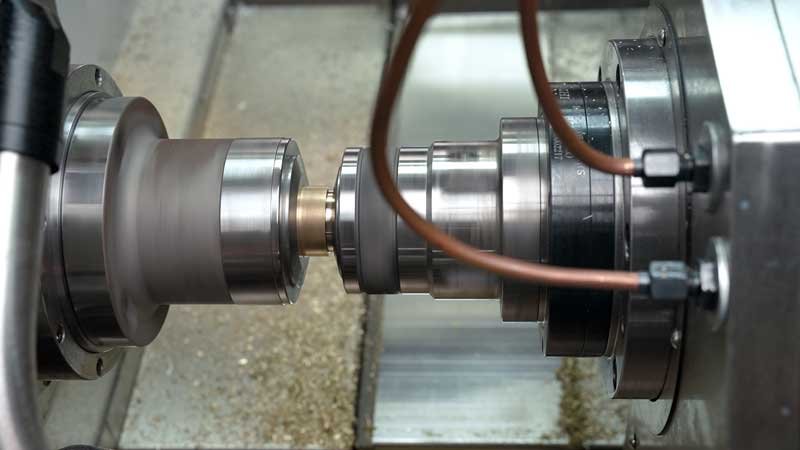Key Choices for Boosting Production Efficiency: Twin-spindle with Single Turret vs. Twin-spindle with Twin-turret CNC Lathes
In modern manufacturing, selecting the right CNC lathe not only significantly enhances production efficiency but also optimizes production costs. For businesses that prioritize high precision and efficiency, the twin-spindle single turret DS-6146SY and twin-spindle twin turret DS-4636DTY CNC lathes have become mainstream options. However, how do you make the best choice between the two? This article will deeply analyze the advantages and application scenarios of these two types of equipment to help you make an informed decision.
1. DS-6146SY Twin-Spindle Single Turret CNC Lathe: A Cost-Effective Choice
If your production tasks require a certain level of flexibility and do not involve overly complex machining processes, the DS-6146SY is undoubtedly an ideal choice. Equipped with twin spindles, this machine allows workpieces to undergo multiple processes in a single clamping, significantly reducing the time and difficulty of changing workpieces.
Advantages:
The twin-spindle design enables flexible transfer of workpieces between the two spindles, facilitating continuous machining, which is particularly suitable for medium-complexity part processing. Even with only one turret, it can efficiently complete most common machining tasks.
Compared to a twin-spindle twin turret lathe, the single turret design is simpler, which results in lower equipment and maintenance costs. If your production requirements do not demand the complexity of a twin turret, a single turret will save you a considerable budget while still ensuring sufficient machining capability.
The single turret's simpler operation and programming make it more accessible for operators with general technical skills, and it is easier to maintain.
Disadvantages:
However, the DS-6146SY twin-spindle single turret CNC lathe has limitations when it comes to processing complex parts. With only one turret, it cannot perform simultaneous machining, which means efficiency may drop in multi-process operations. For production tasks requiring higher speed and complexity, the single turret may fall short.
Additionally, despite the continuous machining capabilities of the twin-spindle design, the single turret structure still extends tool change time in complex processes requiring frequent tool changes, affecting overall production efficiency.
2. DS-4636DTY: The Unmatched Choice for Superior Productivity
If your production tasks demand extremely high efficiency and complex multi-process operations, the DS-4636DTY is an irreplaceable choice. Through the synergy of twin spindles and twin turrets, this machine can complete more complex tasks in a single clamping, significantly increasing both production speed and precision.
Advantages:
The twin-spindle twin turret CNC lathe is synonymous with high-efficiency production. Its design philosophy is to maximize machining time and minimize non-productive time. The dual turret configuration allows the use of two tool systems simultaneously, meaning machining can occur at different positions simultaneously, greatly improving production efficiency.
For businesses that require complex part processing, a twin-spindle twin turret CNC lathe is nearly indispensable. It can simultaneously machine different areas of the same workpiece or machine two separate workpieces at once, drastically shortening production cycles.
The twin turret structure is particularly advantageous in tasks involving multi-face, multi-process machining, significantly reducing tool change time and ensuring continuity in the production process.
Disadvantages:
Despite its powerful capabilities, the high cost of a twin-spindle twin turret CNC lathe can be prohibitive for many small and medium-sized businesses. Besides the initial investment, its complex structure also leads to higher maintenance costs and operational requirements.
For companies that do not fully utilize the machine's high-efficiency production capabilities, investing in a twin-spindle twin turret lathe may not be the best option.
Furthermore, with a larger footprint, the twin-spindle twin turret CNC lathe requires more installation space, which can be a major concern for companies with limited floor space. Additionally, the more complex operation and programming require operators with higher skill levels, which may be a challenge for companies lacking the necessary technical talent.
3.How to Choose the Right CNC Lathe?
When choosing between a twin-spindle single turret and a twin-spindle twin turret CNC lathe, the first step is to clearly define your company’s specific needs. If your production tasks focus mainly on medium-complexity parts and your budget is limited, a twin-spindle single turret CNC lathe is undoubtedly the most cost-effective choice. It offers high efficiency while lowering equipment and maintenance costs, making it the go-to option for many small and medium-sized enterprises.
However, if your production demands are more complex, involving a large number of multi-processes, multi-face machining tasks, and you require higher speed and precision, then the twin-spindle twin turret CNC lathe is your best option for improving production efficiency. Although the initial investment is higher, its advantages in high-efficiency production and complex part processing will deliver significant returns over the long term.
In conclusion, choosing the right CNC lathe is not a simple task. It requires careful consideration of production needs, budget, available space, and technical capabilities. Regardless of which lathe you choose, ensuring that it matches your company’s actual requirements is the wisest decision. In today’s ever-evolving manufacturing industry, only by selecting the most suitable tools can you stand out in the competitive market.






